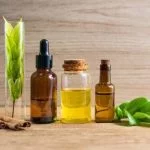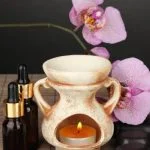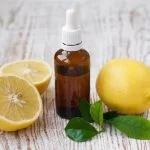Are you looking for a natural way to treat mycosis? In this article, we will explore how to treat mycosis naturally with aromatherapy. Mycosis, also known as fungal infection, can affect the skin, nails, and other areas of the body, causing discomfort and irritation. Understanding the symptoms of mycosis is crucial in finding an effective treatment, and aromatherapy offers a gentle and holistic approach to alleviate these symptoms.
Mycosis can manifest in various forms, including athlete’s foot, ringworm, and nail fungus. Common symptoms may include itching, redness, swelling, and flaking of the affected area. Aromatherapy has gained recognition for its therapeutic benefits in addressing these symptoms naturally. By harnessing the power of essential oils and aromatherapy techniques, it is possible to manage mycosis effectively without resorting to harsh chemical treatments.
In this article, we will delve into the benefits of using aromatherapy for mycosis treatment, exploring essential oils that are known for their antifungal properties. We will also discuss specific aromatherapy methods such as steam inhalation, topical application, foot soaks, and diffuser blends that can effectively alleviate mycosis symptoms.
Additionally, we will cover precautions and considerations for using aromatherapy safely in the treatment of mycosis. Let’s embark on a journey to discover how aromatherapy can offer relief from mycosis in a natural and holistic manner.
Exploring the Benefits of Aromatherapy for Mycosis Treatment
Aromatherapy has been used for centuries as a natural treatment for various health conditions, including mycosis. This holistic healing method harnesses the power of essential oils to provide relief from the symptoms of mycosis, such as itching, inflammation, and discomfort. Aromatherapy is not only effective in alleviating these symptoms but also offers a gentle and natural approach to treating mycosis without harsh chemicals or medications.
The benefits of aromatherapy for mycosis treatment are vast and varied. Essential oils have anti-fungal, anti-inflammatory, and soothing properties that can help combat the fungus causing mycosis while providing relief from discomfort.
Aromatherapy can also boost the immune system, which aids in fighting off fungal infections and preventing their recurrence. In addition to its physical benefits, aromatherapy can also promote relaxation and reduce stress, which can be beneficial for overall well-being when dealing with a condition like mycosis.
When using aromatherapy for mycosis treatment, it is important to select the right essential oils that are known for their antifungal properties. Tea tree oil, lavender oil, peppermint oil, and eucalyptus oil are just a few examples of essential oils that have been used effectively in treating fungal infections. These oils can be used in various methods such as steam inhalation, topical application, foot soaks, and diffuser blends to maximize their therapeutic effects.
Incorporating aromatherapy into one’s daily routine can provide natural relief from mycosis symptoms while promoting overall wellness. By utilizing the benefits of essential oils through aromatherapy, individuals suffering from mycosis can embrace a gentle yet effective approach to managing their condition without relying solely on conventional medications or treatments.
Essential Oils for Mycosis Treatment
Understanding the Power of Essential Oils
Essential oils have been used for centuries to treat various health conditions, including fungal infections like mycosis. These potent plant extracts are known for their antifungal, antibacterial, and anti-inflammatory properties, making them an effective natural remedy for mycosis. When used correctly, essential oils can help alleviate symptoms such as itching, redness, and irritation associated with mycosis.
Top Essential Oils for Mycosis Treatment
When it comes to treating mycosis naturally with aromatherapy, some essential oils stand out for their antifungal properties. Tea tree oil is one of the most popular choices due to its strong antifungal and antibacterial effects. Other essential oils that have shown promise in treating mycosis include lavender oil, oregano oil, and eucalyptus oil. Each of these oils has unique properties that can help combat the fungal infection and provide relief from discomfort.
Safe Application of Essential Oils
It’s important to dilute essential oils properly before applying them to the skin or inhaling them through steam inhalation or a diffuser. Undiluted essential oils can be too strong and may cause skin irritation or allergic reactions.
When creating aromatherapy blends for mycosis treatment, always use a carrier oil such as coconut oil or almond oil to dilute the essential oils. Additionally, perform a patch test on a small area of the skin before using any new essential oil blend to ensure there are no adverse reactions.
By incorporating these essential oils into your aromatherapy routine and following proper safety precautions, you can effectively treat mycosis naturally while enjoying the therapeutic benefits of aromatherapy.
Steam Inhalation
The Power of Steam Inhalation
Steam inhalation is a powerful and effective method for treating mycosis naturally with aromatherapy. When essential oils are added to hot water and inhaled, the steam carries the therapeutic properties of the oils directly to the affected area, in this case, the respiratory system or skin where mycosis may be present. This direct delivery method allows for quick and targeted relief from mycosis symptoms.
Choosing the Right Essential Oils
Not all essential oils are created equal when it comes to treating mycosis. When using steam inhalation as an aromatherapy treatment, it’s important to select essential oils with anti-fungal and antimicrobial properties. Tea tree oil, eucalyptus oil, lavender oil, and peppermint oil are some examples of essential oils known for their ability to combat fungal infections and provide relief from mycosis symptoms.
Steam Inhalation Technique
To use steam inhalation for treating mycosis naturally with aromatherapy, simply boil a pot of water and transfer it to a heat-safe bowl. Add a few drops (2-5 drops) of your chosen essential oil or blend of oils into the hot water. Then drape a towel over your head and lean over the bowl at a safe distance to inhale the steam deeply for about 10-15 minutes.
Be cautious not to get too close to avoid steam burns, and keep your eyes closed during the process. For respiratory mycosis, this can be particularly helpful in alleviating congestion and breathing difficulties.
As you can see, steam inhalation offers an effective way to tap into the healing properties of aromatherapy for treating mycosis naturally. With proper technique and the right selection of essential oils, this method can provide relief from mycosis symptoms while avoiding the use of harsh chemicals or medications.
Topical Application
Aromatherapy has been used for centuries as a natural remedy for various health conditions, including mycosis. When it comes to treating mycosis naturally with aromatherapy, topical application of essential oils is a popular and effective method. This section will explore the benefits of using aromatherapy blends topically for mycosis treatment and provide a guide on creating safe and effective blends.
Topical application of essential oils for mycosis treatment can help alleviate symptoms such as itching, redness, and irritation. Essential oils like tea tree oil, lavender, and oregano have antifungal properties that can effectively combat the fungi causing mycosis. When these essential oils are diluted in a carrier oil such as coconut oil or jojoba oil, they can be safely applied to the affected areas to provide relief.
When creating aromatherapy blends for topical application, it is important to use high-quality essential oils and ensure proper dilution to avoid skin irritation. A general rule of thumb is to use a 2% dilution, which means adding 12 drops of essential oil to every ounce of carrier oil. It’s also essential to perform a patch test before applying the blend to larger areas of the skin to check for any allergic reactions or sensitivity.
Using aromatherapy topically for mycosis treatment can be a safe and effective way to address symptoms and promote healing. The anti-inflammatory and antifungal properties of essential oils can provide relief from discomfort while supporting skin health. With proper knowledge and caution, creating safe and effective aromatherapy blends for topical application can be an integral part of a natural approach to treating mycosis.
| Essential Oil | Dilution Ratio |
|---|---|
| Tea Tree Oil | 2% |
| Lavender Oil | 2% |
| Oregano Oil | 2% |
Aromatherapy Foot Soaks
Mycosis, commonly known as fungal infection, can affect various parts of the body, including the feet. Symptoms of mycosis on the feet can include redness, itching, peeling skin, and discomfort. A natural and effective way to alleviate these symptoms is through aromatherapy foot soaks. Aromatherapy has been used for centuries to treat various ailments, and it can be particularly beneficial in treating mycosis due to its antifungal and soothing properties.
Using essential oils in foot soaks can help not only combat the fungus causing mycosis but also provide relief from the uncomfortable symptoms. Here are some essential oils that are effective for treating mycosis naturally:
1. Tea Tree Oil: Known for its powerful antifungal properties, tea tree oil is a popular choice for treating mycosis. Its antibacterial and anti-inflammatory properties can help reduce redness and irritation on the affected area.
2. Lavender Oil: Lavender oil has antifungal and calming properties that can help soothe itching and discomfort caused by mycosis.
3. Eucalyptus Oil: With its antimicrobial and anti-inflammatory properties, eucalyptus oil can help fight off fungal infections while providing a cooling sensation to ease discomfort.
When creating an aromatherapy foot soak for mycosis treatment, it’s important to dilute the essential oils properly to avoid skin irritation. Here’s a simple recipe for an effective aromatherapy foot soak:
It’s important to note that while aromatherapy can provide relief from mycosis symptoms, it should not replace medical treatment prescribed by a healthcare professional. If you have severe or persistent symptoms of mycosis, consult with a doctor for appropriate diagnosis and treatment options alongside aromatherapy interventions.
Incorporating aromatherapy foot soaks into your self-care routine can be a soothing and natural way to alleviate the symptoms of mycosis on your feet. With the proper use of essential oils and regular foot soaks, you may find relief from discomfort while promoting healing in affected areas.
Aromatherapy Diffuser Blends for Mycosis Relief
Aromatherapy can be an effective natural treatment for mycosis, offering relief from symptoms and promoting overall healing. One popular method of using essential oils for mycosis relief is through the use of a diffuser. A diffuser disperses the essential oil molecules into the air, allowing them to be inhaled and providing therapeutic benefits. By creating specific aromatherapy blends, individuals can customize their treatment for mycosis based on their symptoms and personal preferences.
When using a diffuser for mycosis relief, it is important to choose essential oils known for their antifungal, antibacterial, and anti-inflammatory properties. Tea tree oil, lavender, eucalyptus, peppermint, and thyme are just a few examples of essential oils that have been traditionally used to treat fungal infections and alleviate related symptoms.
To create an aromatherapy diffuser blend for mycosis relief, simply add a few drops of chosen essential oils to your diffuser according to the manufacturer’s instructions. For example, a blend containing tea tree oil as the primary ingredient can help combat fungal growth while also reducing inflammation and discomfort associated with mycosis. Experimenting with different essential oil combinations can help individuals find the most effective blend for their unique needs.
In addition to providing direct relief from mycosis symptoms, using an aromatherapy diffuser can also contribute to a calming and stress-reducing environment. This is important because stress can weaken the immune system, making it more difficult for the body to fight off fungal infections. By incorporating aromatherapy into daily routines through the use of a diffuser, individuals can not only treat mycosis naturally but also promote overall wellness and relaxation.
Precautions and Considerations
Aromatherapy is a popular and effective natural treatment for mycosis, providing relief from symptoms and promoting healing. However, it’s essential to use aromatherapy safely and with caution to ensure the best results and avoid any adverse reactions. Here are some important precautions and considerations for using aromatherapy as a treatment for mycosis.
First and foremost, it’s crucial to dilute essential oils properly before applying them to the skin or inhaling them. Essential oils are highly concentrated and can be irritating or even harmful if used undiluted.
Always mix essential oils with a carrier oil such as coconut oil, almond oil, or jojoba oil before using them on the skin. For steam inhalation, add a few drops of essential oil to hot water but avoid direct contact with the skin to prevent burns.
Additionally, certain essential oils may not be suitable for individuals with specific health conditions such as asthma, allergies, or respiratory issues. It’s important to research and seek advice from a qualified aromatherapist or healthcare professional before using aromatherapy for mycosis treatment, especially if you have any existing medical concerns. Some essential oils may also interact with medications, so it’s important to take these factors into account.
Finally, when creating aromatherapy blends for topical application or diffusing, always perform a patch test first to check for any allergic reactions or sensitivities. This involves applying a small amount of the diluted blend to a small area of skin and waiting 24 hours to see if any adverse reactions occur. This simple step can help prevent potential issues and ensure that the chosen essential oils are safe for use in mycosis treatment.
| Precautions and Considerations | Aromatherapy Safely for Mycosis Treatment |
|---|---|
| Dilute essential oils properly before use | Research potential interactions with existing medical conditions |
| Perform a patch test before topical application | Seek advice from qualified aromatherapist or healthcare professional |
Conclusion
In conclusion, aromatherapy has proven to be a valuable and effective natural treatment for mycosis. By understanding the symptoms and causes of mycosis, individuals can explore the benefits of aromatherapy as a safe and holistic approach to combat this common fungal infection. The use of essential oils in steam inhalation, topical application, foot soaks, and diffuser blends can provide relief from discomfort and aid in the healing process.
The comprehensive guide to essential oils for mycosis treatment offers a variety of options for creating safe and effective aromatherapy blends. Whether it’s tea tree oil, lavender, or eucalyptus, individuals have an array of natural remedies at their disposal. By taking precautions and considering safety measures when using aromatherapy for mycosis treatment, individuals can embrace this natural solution with confidence.
In summary, individuals suffering from mycosis now have access to a natural and holistic approach to alleviating symptoms and promoting healing. With the careful use of essential oils through steam inhalation, topical application, foot soaks, and diffuser blends, aromatherapy offers a gentle yet powerful alternative for managing mycosis. By incorporating aromatherapy as part of a comprehensive treatment plan, individuals can take control of their health in a safe and natural way.

Are you looking for a natural way to improve your health and wellbeing?
If so, aromatherapy may be the answer for you.






